The Anaheim Ducks franchise is at a low point, and if they miss the 2020-21 playoffs (whenever that may be), they will tie a franchise record for missing the postseason. The Ducks have twice missed qualifying in three consecutive seasons, and both came within their first decade in existence.
Related: Maple Leafs’ Forgotten Ones – Jeff Finger
General manager Bob Murray is trying desperately to make sure it doesn’t happen, and part of that will be trying to formulate a roster that can compete as fast as possible. Murray has drafted several players over the past few seasons that many hope will be the future core of a Stanley Cup contending team. However, now that we’ve seen a group of young players compete at the NHL level, it’s worth asking: Are any of the Ducks’ youngsters expendable?
Hypothetical or Possible?
While anyone can be included in a trade if the return is tempting enough, the odds that Trevor Zegras will be is slim to none. The Athletic‘s Eric Stephens and Lisa Dillman explored a hypothetical offer to entice the Buffalo Sabres to trade Jack Eichel to the Ducks. They included Zegras in that discussion, but it was primarily a hypothetical exercise likely born out of a lack of Ducks and Kings hockey during the coronavirus pandemic (From ‘Should the Ducks try to trade for Jack Eichel (if he wanted out of Buffalo)?’ The Athletic, 6/19/2020).
Some of the Ducks’ early-round picks from previous drafts haven’t played themselves into untouchability, though. Add to that the uncertainty surrounding the salary cap caused by coronavirus and the upcoming expansion draft, which is supposed to happen in roughly a year, and that makes significant roster shuffling more likely.
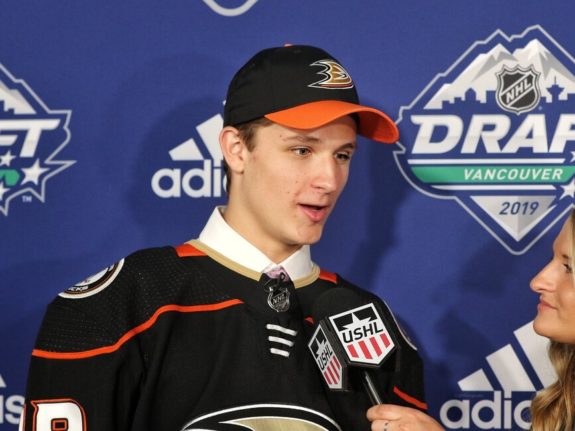
To be clear, none of the following players have been included in recent trade rumors, this exercise is also purely hypothetical. Of the Ducks’ prospects who have played a reasonable number of NHL games, there are four who the team has substantial expectations for, so let’s see if any would be trade bait.
Steel of a Deal?
From the forward group that includes Sam Steel, Max Jones, Troy Terry and Max Comtois, only Steel spent the entirety of the shortened 2019-20 season in the NHL. In his total 87 games of NHL experience, he has scored 12 goals and added 21 assists for 33 points. He also improved his Corsi-for percentage at 5-on-5 from an abysmal 43.8% to a more acceptable 48.5%.
Steel might not yet be creating an overwhelming number of scoring chances or driving play; however, his game has shown some indicators that improvement will come, especially in the opponents’ zone.
The goals Steel did score had some encouraging elements to them. At 5-foot-11, he isn’t big enough to impose his will physically in the offensive zone. Still, four of his six goals resulted from his timing and tenacity in front of the net. This goal against the New York Rangers showcases both.
Steel hangs right on top of Henrik Lundqvist and charges right to the front of the net in the face of 6-foot-3, 209-pound Jacob Trouba to bat the rebound past the Ranger goaltender. It’s a perfect example of how Steel is willing to spend time in more physical areas of the ice to score on rebounds and deflections. He can sneak into dangerous areas of the offensive zone, which he also demonstrated on a number of his other goals in 2019-20.
Steel Showing Good Signs Early
What does this have to do with his value to the Ducks relative to a trade? Coming into the league, experts touted Steel as a creative speedster and a playmaker. That skillset is easier to rely on when you’re a big fish in a smaller pond like he was in the Western Hockey League (WHL). It even applies in the American Hockey League (AHL) where he scored 20 goals and added 21 assists in 53 games in 2018-19.
Related: One for the Ages – Billy Smith’s 1981-82 NHL Season
But playing in the world’s best league with the best players on the planet, especially only 87 games in, means you can’t rely on speed and skill. Steel has shown a willingness to score dirty goals and spend time in the areas where will and tenacity bring results as much as skill and creativity do. That suggests that as Steel gains more NHL experience and more confidence, he’ll eventually be able to score by pure talent and skill. Add that to the production he’s already managed by being willing to play in tougher parts of the ice and you’ve got a dangerous player.
As the Ducks improve their roster and add more offensive weapons, Steel’s game is likely to benefit. With more rebounds and offensive opportunities to capitalize on, he should increase his numbers.
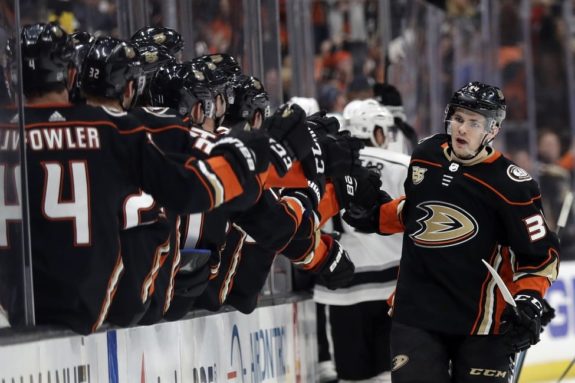
Even with his lack of eye-popping numbers, Steel is probably the least likely of the group of he, Jones, Comtois and Terry to see his name included in a trade, unless it’s something big.
Jones Acclimating to the NHL
Like Steel, Jones took another step in his development in 2019-20, playing 59 games with the Ducks and totaling 89 in two seasons. He scored 8 goals, up from 2 the previous season and added 4 assists for 12 points.
Jones averaged more than a minute less of playing time per season than Steel as mostly a third-line and sometimes second-line winger when he was with the Ducks and not in San Diego.
While his scoring ability and physical game were significant factors in the Ducks drafting him No. 24 overall in 2016, his offensive contributions have gradually grown.
Jones hasn’t placed himself in the untouchable category, either. But, his hands and creativity around the goal make him an asset the Ducks should want to keep considering their continued inability to score.
This goal from Jones is a perfect example. He uses his large frame to get around the Arizona Coyotes defender. Rather than trying to awkwardly shovel Steel’s pass from his backhand into the net, he gets on one knee and places his entire stick flush to the ice to act as a wall for his teammate to bounce the puck off.
It results in a nifty-looking goal. Those are the instincts that helped him score so often in major junior, and the confidence to do that in the NHL shows that Jones is feeling more comfortable at the highest level.
The Ducks are starting to pile up players on the wing, but Jones feels like he has established himself.
Comtois Does the Little Things
Following the tease that was Comtois’ 10-game stint for the Ducks to start the 2018-19 season, his performance in 2019-20 was subtler. Chalk that up to the high expectations he set in his first NHL experience or the lack of opportunity last year (he played only 29 NHL games), but I always thought Comtois might be the best of the group of he, Steel, Terry and Jones.
Comtois spent three different stints in the AHL in 2019-20, including almost a month from November to December and then for good following his demotion in mid-January. He played well in the AHL, scoring 9 goals and adding 15 assists in 31 games.
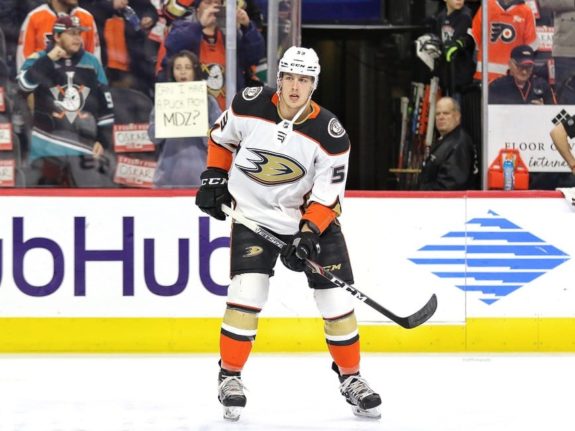
But, for a player like Comtois, his versatility matters as much as his goal-scoring ability. Whereas Terry’s skills might be much more valuable on a top line, Comtois’ can be utilized anywhere. He’s already a strong defensive zone player, winning battles physically and not afraid to throw his body around or fight. He can also facilitate the transition quickly, and when things are going well, he can score in bunches.
A Pro’s Pro
Jordan Samuels-Thomas of The Athletic does a perfect job breaking down not only what it is about Comtois’ game that makes him so important, but also why he’d be more effective playing full-time in the NHL next season.
It appears that Comtois’ offensive game is better suited for the NHL even with his recent surge of production in San Diego.
In the NHL, everyone is where they should be. Players are slotted in proper roles for success. The correct play is made with and without the puck more often than not. Predictability is a key component to comfort on the ice, and the AHL as a developmental league can be chaotic at times.
That was a long-winded way of saying Comtois looks more comfortable on offense with the Ducks than he has with the Gulls.
Samuels-Thomas continues:
Not only has his play in the defensive zone helped thwart the attacks of the opposition, but it’s also translated into offense for the Gulls. The rookie has looked like a 10-year veteran in the defensive-zone breakout and transition. Comtois plays controlled but fast in these situations, and that plays right into what coach Dallas Eakins wants in Anaheim for transition play.
(From ‘Why the NHL will suit Max Comtois better than the AHL’ The Athletic, 3/4/2020).
That all goes to say Comtois is developing into a two-way forward who’s as important when he’s scoring as when he’s not. With an infusion of young players coming into the Ducks organization, it helps to do a lot of things to stick in the NHL. Comtois has that toolkit, which makes him less expendable than Terry, perhaps even Steel and Jones.
Terry’s Injuries Hampered Slowed His Experience
Since the Ducks picked Terry No. 148 overall in 2015, expectations for him have felt more like those attached to a first-rounder. He made his NHL debut for the Ducks in March 2018, but two full seasons later still hasn’t become a full-time NHL player.
Part of that is a result of the Ducks’ philosophy not to rush players to the NHL too early and keep them in the minors until they are more than ready. Terry has been up and down both literally from the NHL to the AHL and in terms of his NHL play.
Related: Oilers History – The Paul Coffey Effect
His first two games in 2018 weren’t impressive, nor was his first stint with the Ducks in 2018-19 filling in for a heavily injured Ducks forward corps. When he returned in Jan. 2019, he looked much more confident after having spent a significant portion of time in San Diego under now-Ducks coach Dallas Eakins. That confidence resulted in four multi-point games, including a three-assist effort in early March against the future Stanley Cup champion St. Louis Blues.
This season felt underwhelming considering Terry’s step forward at the end of 2019. Though he made a concerted effort to put more shots on goal, increasing his shot per game output from 0.78 to 1.55 per game, it didn’t result in a sizable jump in points.
That is despite playing 15 more games in the NHL in 2019-20 versus 2018-19 and averaging over 30 seconds more time on ice.
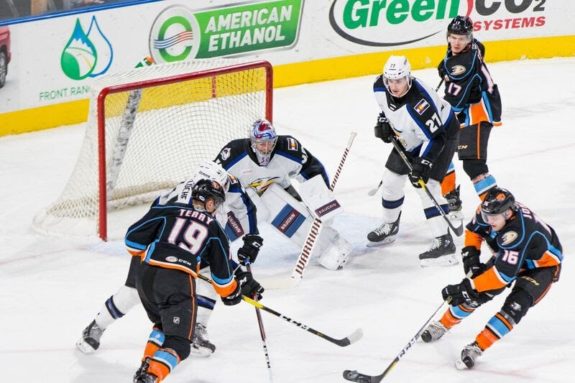
Terry’s struggle with injury has undoubtedly hampered his development. He has broken his tibia and then a bone in his knee in consecutive seasons, but that isn’t to say he won’t develop into an NHL contributor.
Would Terry Be Better off on Another Team?
The bottom line is that Terry isn’t a player you put on the fourth line to grind down opponents. He’s a top-nine skill player who can make difficult passes and use his creativity and hands to generate scoring chances. You could argue that the Ducks need Terry as much as they need Jones and Steel if they develop into more significant offensive threats.
However, with the addition of pending restricted free agent Sonny Milano, and the potential future arrival of Brayden Tracey, things might start to get tight on the wing for Terry. Don’t forget he’s competing with Comtois as well.
That might make him expendable in the upcoming seasons. If the Ducks are in pursuit of added draft capital in the upcoming draft, might he be part of a package to pry a second or third-rounder away from a contending team that could use his cheaper contract and potential?
While it’s challenging to part with a player they have been so hopeful about, it might be an upgrade. If the Ducks can collect a pick in the first three rounds of the draft for a player they picked at the end of the fifth round, that could be considered an upgrade. Add to that the fact that the Ducks are now clearly in an extensive rebuild rather than a retool; an additional high-round draft pick might be more valuable than Terry to the team right now.
Expansion Draft Spectre
Might he be included in a trade before the expansion draft in 2021 to keep the Seattle franchise from picking a player the Ducks could not protect?
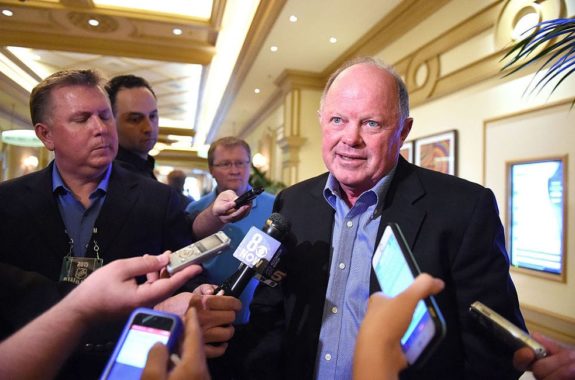
While the stinging loss of Shea Theodore and the Blue Jackets’ cautionary tale of trading William Karlsson might give Ducks fans anxiety, it’s not something to be ignored considering the popularity of such moves in 2017.
With a team trying to transition from losing to winning again like the Ducks, having a collection of talented young players is vitally important. That sounds obvious, but it’s a reason for holding onto players like Steel, Terry, Jones and Comtois. But since it looks like the Ducks might be losing for another season, sending one of them to another team or using one as bait in the expansion draft isn’t out of the question. Considering their skillsets and development, that player is probably Terry.
All stats from hockey-reference.com and naturalstattrick.com